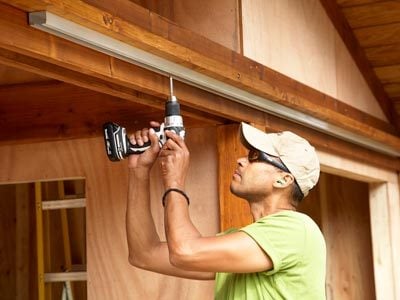Walls are easy. It's the openings that are hard to figure out.
What to Know About Sliding Shed Doors

For several years now, I’ve been in charge of designing and building our annual shed. The photo here gives you a look at the shed that appeared in our July/Aug. ’12 issue.
Types of Shed Doors
One of the details that always demands my attention is the number and type of doors to include. Several of the sheds I’ve designed have two doors—a regular entry door and a large door for riding lawn mowers and other big stuff. Entry doors are easy. I usually just buy prehung exterior shed doors like you’d install in a garage or house. Big doors are a little more challenging. After experimenting with various methods, I’ve settled on a sliding shed door as the best solution.
Sliding Shed Door Advantages
Sliding doors have several advantages over hinged doors for wide openings. First, there’s practically no limit to the size of the door you can use. And since the doors hang from the top rather than from one edge like a hinged door, they don’t have to be quite as strong. Plus, they don’t require as much room to open as hinged doors. I had a pair of hinged doors on a shed at my last house, and in the winter I had to keep a large area in front of the shed free of snow and ice buildup or the doors wouldn’t open. This isn’t a problem with sliding doors.
Building Sliding Shed Doors
The key to building a good sliding shed door is using the right hardware. I think the heavy-duty bypass door hardware from Johnson Hardware (johnsonhardware.com) is the perfect solution. The system consists of heavy-duty three-wheel ball-bearing hangers (Part No. 1025) that can support doors up to 150 lbs. and an aluminum track Part No. 111). An 8-ft. track and a pair of hangers for a 4-ft. door cost about $70.
For the bypass hardware to work on a shed, you have to have a strong place to anchor the top track. I accomplish this by ripping a 2×4 down to between 2-1/2 and 3 in. (depending on how thick the door is) and attaching it to the shed wall with lag screws. Then I screw the aluminum track to the 2x support. The last step is to mount the hanger plates to the top of door.

Sliding Door Drawbacks
Sliding doors offer a good alternative to hinged doors, but they do have a few drawbacks. First, they’re harder to lock. I haven’t found an elegant solution for locking a sliding door and usually end up using a hasp and padlock or a lockable gate latch if there’s a pair of doors. The other problem with sliding doors is that they’re trickier to seal. If you’re worried about bugs or small creatures getting into the shed, consider hinged doors instead. But if you want a door that’s easy to build and install, easy to operate and doesn’t take up much space, then it’s hard to beat sliding doors.
— Jeff Gorton, Associate Editor



















